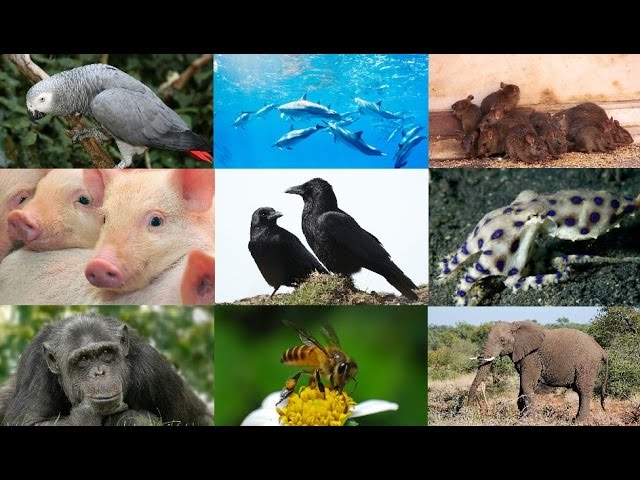10 Most Intelligent Animals. There’s no one definition for what makes an animal smart. It could be their ability to see further or hear more, or it could be their reasoning skills and self-recognition. These are just a few examples of “intelligence” and there are many other animals who are smarter than you might think.
Ravens and Crows
Table of Contents
All birds of the corvid family are clever. This bird group includes magpies, jays, ravens, and crows. All these birds are the only non-primate vertebrates that invent their own tools. Crows recognize human faces better than any other bird, communicate complex concepts with other birds, and think about the future. Experts compare crow intelligence to that of a 7-year-old child who thinks more abstractly.
Chimpanzees
Chimps show intelligence similar to that of humans, and they respond to different emotions as well. They make tools, communicate with humans through sign language, and have learned to recognize themselves in a mirror.
Elephants
Elephants have the largest brains of any land animal. That’s because their cortex has as many neurons as a human brain, and people can remember things for more than 10 years. They cooperate with each other, demonstrate self-awareness, and engage in play just like primates and birds.
Gorillas
Like humans and chimpanzees, gorillas are primates. Gorillas, like Koko the gorilla, can form original sentences and understand the use of symbols to represent objects and more complex concepts.
Dolphins
Dolphins and whales are even smarter than birds, which makes them more like primates. Like primates, they’re mammals too! Dolphins have a large brain relative to its body size. The cortex of a human’s brain is highly convoluted, but dolphins’ is even more! Dolphins and their kin are the only marine animals that have passed the mirror test of self-awareness.
Pigs
Pigs are excellent at maze solving, understanding and demonstrating emotions, as well as understanding and displaying symbols. Six-week-old piglets that see food in a mirror can figure out where the food is located. In comparison, human babies have to engage their brains for several months before they figure this out. Pigs also have an ability to understand abstract representations and use this skill to play video games using a joystick.
Octopuses
While we’re most familiar with intelligence in other vertebrates, some invertebrates are incredibly clever. The octopus has the largest brain of any invertebrate, yet three-fifths of its neurons are actually in its arms. The octopus is the only invertebrate known to use tools. One octopus called Otto even went as far as to throw rocks and spray water at the bright overhead lights of his aquarium to short them out.
Parrots
Although people usually don’t attribute parrots with advanced cognitive skills, these birds are actually as intelligent as a human child. African Grey parrots, for example, can learn an impressive number of words and use them in context to communicate
Dogs
Man’s best friend uses its intelligence to communicate with humans. They understand emotions, show empathy, and understand symbolic language. According to canine intelligence expert Stanley Coren, the average dog understands 165 human words. However, they can learn many more. He estimated that a border collie named Chaser understood 1022 words!
Raccoons
Researchers at the USDA National Wildlife Center and the University of Wyoming found that when they gave raccoons a pitcher of water with some marshmallows in it, half of them figured out how to reach the treats. This could be compared to the fable of The Crow and the Pitcher, written by Aesop.
Other Smart Animals
While these ten animals seem like they’re a good place to start, the list barely touches the surface of what animal intelligence can actually be. Other animals that boast super-smarts include rats, squirrels, cats, otters, pigeons and even chickens. Colony-forming species like bees and ants display a different sort of intelligence. While little individual bugs might not accomplish great feats, insects work together to solve problems in a way that’s difficult for vertebrate animals.











